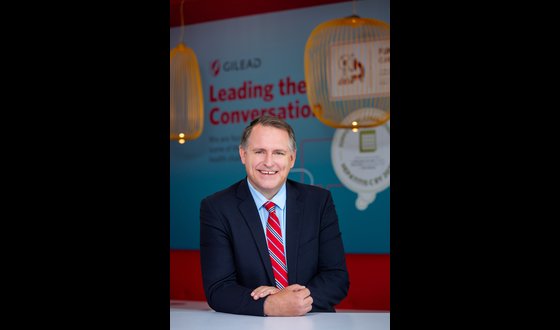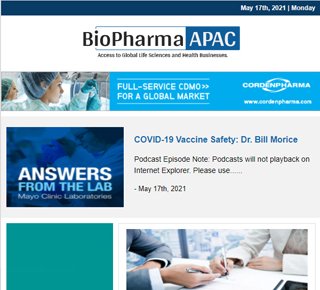Looking ahead, it is important that we glean the lessons learned from the pandemic and apply them in our current and future plans to help improve our efforts towards ending the HIV epidemic : Dustin Haines
25 October 2022 | Tuesday | Influencers

Dustin Haines ,VP and General Manager Asia at Gilead Sciences
Q1. What emerging trends are shaping the future of research in Virology?
This is an extraordinary time in which infectious disease research is central to everyday life. One of the major takeaways is how much of the science underpinning our response to COVID-19 was built upon years of previous research on other related viruses. Veklury was originally developed for the potential treatment of the Ebola virus infection and has been repurposed against SARS-CoV-2, the virus causing COVID-19. The speedy approach used to tackle SARS-CoV-2 could change the future of virology research.
For a start, the large clinical trials for COVID-19 treatment options, including Veklury, should provide data that are more widely useful for understanding immune responses. Given all the detailed information collected on patient demographics, clinical and viral load responses, and so on, we might learn much more these past two years than in previous decades. What we have learned from the study from one virus might not be directly applicable to other viruses but can point us in many of the right directions. The collaboration that took place during COVID-19 provided a leapfrog moment for virology research.
A pioneer and leader in antiviral development, Gilead has been at the forefront in the development of transformative medicines to meet global public health challenges. We apply our deep-rooted expertise in virology to develop a cure for hepatitis C virus. We are heavily investing in research and development to advance treatments for life-threatening diseases. We believe that we can one day achieve functional cure of HIV, hepatitis B and hepatitis D.
Q2. What are the challenges you anticipate in ending the HIV pandemic post-COVID and rebuilding strategies?
As we transition to a post-COVID future, our priorities here in Asia remain focused on how we can improve the patient journey – through greater access to education and information about their disease, deepening and ensuring more meaningful interaction with their physicians.
The COVID-19 pandemic massively disrupted health services across the board. For HIV, it has caused significant declines in testing, prevention and treatment services, according to a study evaluating the impact of the pandemic on HIV service access and delivery in Asia. We saw decreased hospital and clinic visits (persons living with HIV: 35.9%, at risk populations: 57.5%), interruptions in antiretroviral therapy (22.3%) and decreased/complete stop of HIV prevention medication consumption (40.9%) due to factors including lockdown measures impacting distribution of medicines and travel constraints. In addition, more than half of people living with HIV and key populations across the region did not use telehealth services, despite majority of HCPs providing remote HIV prevention and care through telemedicine. Many of the communities that were hardest hit by the pandemic are the communities that already face significant social and structural barriers to health, such as poverty, illiteracy, and unstable employment.
As we attempt to get back on track with our HIV response, we need to make sure all communities are recovering and to recognize that some communities are going to need greater investment in resources because they’re disproportionately impacted.
Despite having made good progress towards ending the epidemic, stigma is still widespread, with the majority of our communities feeling uncomfortable, uninformed, and concerned about HIV and people living with it. There is much work that needs to be done to address this barrier before we can truly end the epidemic.
Q3. What gaps need to be filled to end the HIV epidemic?
Several barriers continue to affect the progress in reaching the 2025 UNAIDS targets. These include social barriers such as stigma and discrimination against people living with HIV and other communities. The pandemic has amplified the role of testing and screening in this fight against the HIV epidemic. Governments in Asia should pay more attention and ramp up efforts to further entrench testing into routine healthcare practices, increasing number of touchpoints for patients to receive a HIV test as part of other services, which will help reduce stigma of testing and encourage testing uptake.
A structural barrier to the HIV epidemic challenge would be the lack of access to affordable health and social care services which can be addressed through offering the option of using telehealth services. However, given that there is still a majority of persons living with HIV and at risk populations not adopting telehealth, this highlights a lack in universal policies and guidelines for telehealth in many countries across Asia. Hence, we need to work with the governments to better understand patients’ preferences to deliver quality HIV care via telemedicine post-COVID-19 pandemic. Other barriers include the lack of access to stable housing, which can limit options for often multi-marginalized groups to access the HIV-related services they need.
To address these in Asia, Gilead is partnering with International AIDS Society (IAS) for the “Me & My Healthcare Provider” campaign. The campaign promotes best practices in inclusive and stigma-free healthcare service delivery for people living with and vulnerable to HIV by leveraging the voices of healthcare professionals – who are trusted sources for management of health in Asia. We also continue to invest in and advance partnerships with community-based organizations through initiatives such as the Asia Pacific Rainbow Grant and ALL4LIVER Grant which are aimed at eradicating global public health threats including HIV and viral hepatitis. These grants provide funding earmarked to support initiatives to enhance education about viral hepatitis led by community-based organizations (CBOs) across Asia Pacific.
Q4. What are your insights into the current state of oncology R&D?
Oncology research is important to improve the prevention, detection and treatment of cancers, and ensure that survivors live longer, better quality lives. In August this year, we announced new data to be presented across its oncology pipeline at the European Society for Medical Oncology (ESMO) Congress 2022. This includes an oral presentation of late-breaking overall survival results from the pivotal Phase 3 TROPiCS-02 study of Trodelvy in pre-treated patients with HR+/HER2- metastatic breast cancer. The results, which add to and expand on the positive progression-free survival data presented earlier this year at American Society of Clinical Oncology (ASCO), showed that Trodelvy extended overall survival by 3.2 months compared to the physician’s choice of treatment. Though Trodelvy has not been approved by any regulatory agency for the treatment of HR+/HER2- metastatic breast cancer, the new data points to the need for health systems to look at possible broader application of the regimen for the benefits of the patients – on top of its current indication for patients of triple-negative breast cancer. In our R&D efforts, we will continue to look for unique ways to treat patients and bring hope to them and their families.
Q5. How do you see the opportunity for Asia in BioPharma R&D industry?
Asia comprises of a broad range of ethnicities and is home to at least 60% of the world’s population. Within the next 10 years, the region is projected to have the highest incidence rates for cancer and noncommunicable diseases.
Asia is therefore an important base for R&D for the biopharmaceutical industry and will continue to be one in years to come. Availability of a vast patient population, affordable costs, R&D workforce and a favorable regulatory environment are some of the driving factors behind this phenomenon.
Since 2011, Gilead saw more than 150 investigator sponsored research and 90 clinical trials in Asia as we remain deeply committed to our common goal of improving patients’ health.
When COVID-19 first emerged, Gilead Asia was quick to respond to advance our then-investigational antiviral which had shown potential against other coronaviruses in laboratory and preclinical experiments, deploying decades of antiviral expertise and significant internal resources to help patients and communities working to ease the burden of the pandemic. To date, Veklury and generic remdesivir have been made available to more than 11 million patients around the world.
Looking ahead, it is important that we glean the lessons learned from the pandemic and apply them in our current and future plans to help improve our efforts towards ending the HIV epidemic. While science and innovation are always crucial to treatment, equal attention must be paid towards the role of governments and community-based organizations in educating our audiences, expanding outreach and increasing testing uptake.
Most Read
- How Health Systems Are Reshaping Drug Adoption, Partner Models, and Market Access in 2026
- Top 25 Biotech Innovations Redefining Health And Planet In 2025
- The New AI Gold Rush: Western Pharma’s Billion-Dollar Bet on Chinese Biotech
- Top 25 Biotech & Biopharma Leaders in Sustainable Innovation, 2025
- China’s Biopharma Dealmaking Surges in H1 2025, Driven by Record Licensing and Oncology Focus
- Chikungunya in China: How a “Forgotten” Arbovirus Found the Perfect Storm
- How Innovation Gaps in Biopharma Raise New Safety Concerns
- Smart Implants and the Future of Musculoskeletal Injury Treatment
- How Ethical Gaps in Psychiatry Could Undermine Biopharma Progress
- The Evolving Landscape of Women’s Health Innovation in the Asia-Pacific
- Using NLP-Driven Decision Support in Emergency Health Assistance
- Taiwan Steps Into the Global Spotlight With a New Cancer Therapy
- The Role of Unique Device Identification (UDI) in Tracing Medical Device Safety
- The Importance of a Patient’s Mental Health During Clinical Trials
Bio Jobs
- The State of Biotech and Life Science Jobs in Asia Pacific – 2025
- Avantor’s New CEO Ligner Aims to Unlock Global Potential and Deliver Shareholder Value
- AstraZeneca Commits $50 Billion to U.S. Expansion by 2030 in Biggest-Ever Global Investment
- Thermo Fisher, SAMRC, and South Africa’s Department of Science and Innovation Launch CATIR to Nurture Next-Gen Scientists
- Cube Biotech Appoints Former Sartorius CEO Dr. Joachim Kreuzburg to Board of Directors
- FDA’s AI Transition Marks a Turning Point in Drug Review: Industry Faces Pressure to Adapt Amid 20% Workforce Cut
- WuXi XDC Completes Mechanical Build of Singapore Bioconjugate Manufacturing Hub
News
Editor Picks











